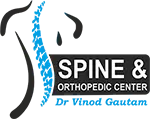Dr. Vinod Gautam
Spine Tumor Doctor in Ahmedabad

If you have back pain, neck pain, or symptoms associated with a spinal disorder, such as scoliosis, you are not alone.
Back Pain
The National Institutes of Health (NIH) estimate that 70% to 85% of all people have back pain at some point in their life. There is no simple cause for back pain, however. It is sometimes possible to trace your pain to an accident or to wear and tear that has happened over time. What is more, back pain is the most common reason why the average person has to take a day off work, avoid physical activity or exercise, or change their daily routine. Back pain is also one of the most common reasons why someone visits a doctor. Fortunately, many back problems will go away with time and a few simple remedies, without surgery or prescription medications.
Neck pain
Neck pain and symptoms caused by a cervical spine (neck) disorder are a very common problem for many adult Americans. The cervical spine is composed of many different anatomic structures, including muscles, bones, ligaments, and joints. Each of these structures has nerve endings that can detect painful problems when they occur. The different parts of the cervical spine are normally well balanced and able to handle all of the movements, stresses, and strains of the body gracefully. However, when the different parts of the cervical spine are injured or start to wear out, your neck can be a significant source of pain and discomfort.
Scoliosis
Scoliosis is a condition that affects the spines of many children, teenagers, and adults. The human spine features many natural curvatures that help our bodies to move and be flexible. When scoliosis is present, the spine develops a lateral curvature, which varies in severity depending on each individual and their course of treatment. There are many causes of scoliosis, including congenital spine deformities, genetic conditions, neuromuscular problems, and limb length inequality. Other causes for scoliosis include cerebral palsy, spina bifida, muscular dystrophy, spinal muscular atrophy, and tumors. Over eighty percent of scoliosis cases, however, are idiopathic, which means that there is no known cause. Most idiopathic scoliosis cases are found in otherwise healthy people.





